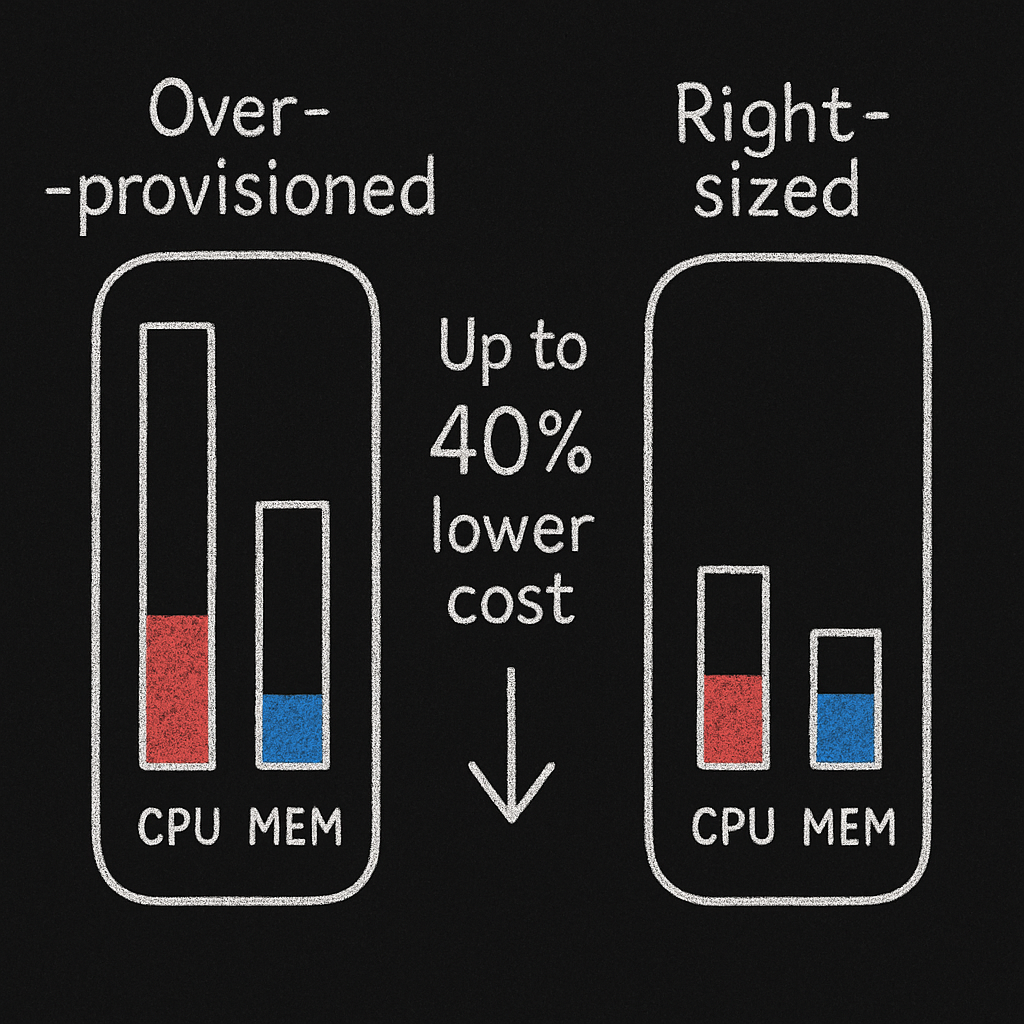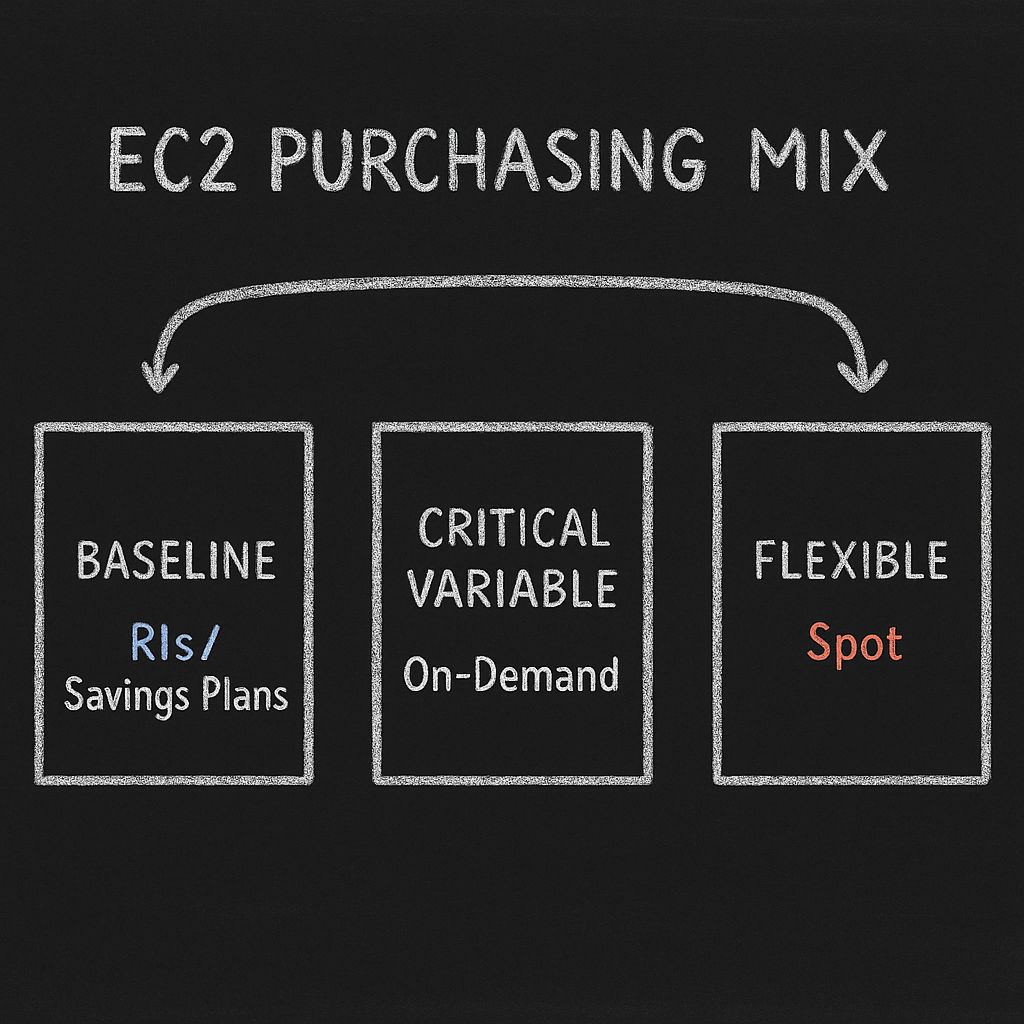AWS EC2 cost optimization: practical strategies for up to 40% savings
Are you throwing away 20-30% of your AWS EC2 budget on oversized or idle instances? For companies running hundreds of EC2 instances, this translates to thousands—or even millions—of dollars in unnecessary cloud costs annually. Yet many DevOps teams lack the bandwidth to thoroughly optimize their environments.
This guide provides actionable EC2 cost optimization strategies that deliver substantial savings without compromising performance.
Understanding EC2 cost optimization
EC2 cost optimization involves systematically analyzing and adjusting your instance configurations, purchasing models, and operational practices to reduce expenses while maintaining or improving performance. This encompasses:
- Selecting appropriate instance types and sizes
- Choosing cost-effective purchasing options
- Managing storage efficiently
- Implementing automation for continuous optimization
Rightsizing: the foundation of EC2 optimization
Rightsizing is the process of matching instance types and sizes to your workload requirements, eliminating waste from over-provisioning while ensuring adequate performance.
Identifying rightsizing opportunities
AWS Compute Optimizer identifies instances as candidates for rightsizing when they show:
- Less than 40% CPU/memory utilization over 4+ weeks
- Running at least 50% of the observation period
By default, AWS Compute Optimizer uses 20% headroom and P99.5 utilization thresholds when generating recommendations, though these can be customized based on your risk tolerance.
Rightsizing tools and approaches
The most effective tools for identifying rightsizing opportunities include:
- AWS Compute Optimizer: Analyzes utilization patterns across CPU, memory, storage I/O, and network throughput for EC2 instances, Auto Scaling groups, EBS volumes, and Lambda functions
- CloudWatch with custom dashboards: Provides deeper insights when combined with the CloudWatch agent for memory metrics
- Third-party cost optimization platforms: Offer automated, continuous optimization
Real-world rightsizing results
Organizations have achieved up to 40% reduction in AWS costs through automated rightsizing while maintaining or improving performance. For example, migrating from a t3.xlarge to an r6g.large instance can deliver potential savings of 40% for memory-intensive workloads with modest CPU requirements.

Optimizing instance family selection
EC2 offers various instance families optimized for different workload characteristics:
General purpose vs. compute optimized
- General Purpose (T3, M5, M6): Best for web servers, small databases, development environments, code repositories, and other balanced workloads
- Compute Optimized (C5, C6): Ideal for compute-intensive applications, batch processing, media transcoding, high-performance web servers, and scientific modeling
For high-performance computing workloads, prioritize instances with high base clock speeds (3.5 GHz+) to maximize performance as outlined in AWS EC2 performance tuning best practices.
EC2 purchasing models: choosing the right option
AWS offers several purchasing models that can significantly reduce costs compared to On-Demand pricing:
Reserved Instances (RIs)
Reserved Instances provide a significant discount compared to On-Demand pricing in exchange for a term commitment (1 or 3 years). RIs are ideal for predictable workloads with steady state usage.
Savings Plans
Savings Plans offer similar discounts to RIs but with greater flexibility across instance families, sizes, and even some other AWS services. These are ideal for organizations that need flexibility in their instance types while still committing to a consistent amount of usage.
Spot Instances
Spot Instances allow you to use spare EC2 capacity at steep discounts compared to On-Demand prices. These are perfect for fault-tolerant, flexible, non-production workloads like batch processing, CI/CD pipelines, and testing environments.
Strategic purchasing model mix
Most organizations benefit from a mixed purchasing strategy:
- Reserved Instances or Savings Plans for baseline, predictable workloads
- On-Demand for variable but critical workloads
- Spot Instances for non-critical, fault-tolerant applications
For more information on enterprise discount programs, see the AWS EDP guide.

EBS optimization strategies
Storage costs can represent a significant portion of your EC2 bill, making EBS optimization crucial.
EBS volume type selection
AWS Compute Optimizer identifies 20-30% of EBS volumes as candidates for optimization based on historical usage data. One of the most impactful changes is upgrading from gp2 to gp3 volumes, which provides better performance at the same or lower cost as highlighted in AWS EC2 performance tuning.
EBS rightsizing opportunities
EBS right-sizing can reduce costs by up to 50% in some cases, particularly for organizations that initially over-provisioned volumes. Key strategies include:
- Identifying and eliminating unused volumes
- Rightsizing volumes based on actual utilization
- Implementing lifecycle policies to transition data to more cost-effective storage classes
For detailed guidance on optimizing EBS performance while controlling costs, check out AWS EBS performance optimization strategies.
Kubernetes cost optimization on AWS
Running Kubernetes on AWS introduces additional complexity and cost optimization opportunities.
EC2 instance selection for EKS
For EKS clusters, carefully select instance types based on your workload characteristics:
- Memory-optimized instances (R5, R6g) for Java applications and memory-intensive workloads
- Compute-optimized instances (C5, C6g) for batch processing and CPU-intensive applications
- General-purpose instances (M5, M6g) for balanced workloads
Node autoscaling and pod placement
Implement the Kubernetes Cluster Autoscaler to automatically adjust the size of your EKS cluster based on current demand. This ensures you’re only paying for the compute resources you actually need.
Automation and monitoring best practices
Manual optimization is time-consuming and often neglected. Automation is key to sustainable cost optimization.
Continuous monitoring and alerting
Set up CloudWatch metrics to monitor key performance indicators:
- CPUUtilization
- MemoryUtilization (requires CloudWatch agent)
- NetworkIn/NetworkOut
- DiskReadOps/DiskWriteOps
Create alarms for both under-utilized and over-utilized resources to trigger automated or manual remediation.
Automated optimization
Implement automation for:
- Starting/stopping development instances during off-hours
- Rightsizing instances based on utilization patterns
- Applying instance purchasing recommendations
- Identifying and removing unused resources
Organizations following the AWS cost management best practices with automation typically achieve better cost-to-performance ratios compared to manual optimization approaches.
Maximizing savings with Hykell’s automated optimization
While the strategies above can be implemented manually, many organizations lack the time and expertise to continuously optimize their EC2 environments. Hykell provides an automated solution that can:
- Continuously analyze your EC2 and EBS usage patterns
- Automatically implement optimizations like rightsizing and storage optimization
- Provide detailed cost savings reports and recommendations
- Deliver up to 40% savings with a pay-only-if-you-save pricing model
With Hykell, you gain the benefits of expert optimization without the ongoing engineering effort, allowing your team to focus on innovation rather than cost management.
Balancing performance and cost
Effective EC2 cost optimization isn’t about cutting corners—it’s about eliminating waste and making informed decisions. By implementing the strategies outlined in this guide, organizations can typically reduce their EC2 costs by 30-40% while maintaining or improving performance.
The most successful approach combines rightsizing instances based on actual utilization, selecting appropriate instance families, leveraging cost-effective purchasing models, optimizing EBS storage, and implementing automation for continuous optimization.
Ready to stop wasting AWS budget? Contact Hykell to learn how our automated optimization solution can help you achieve significant savings with minimal effort.
